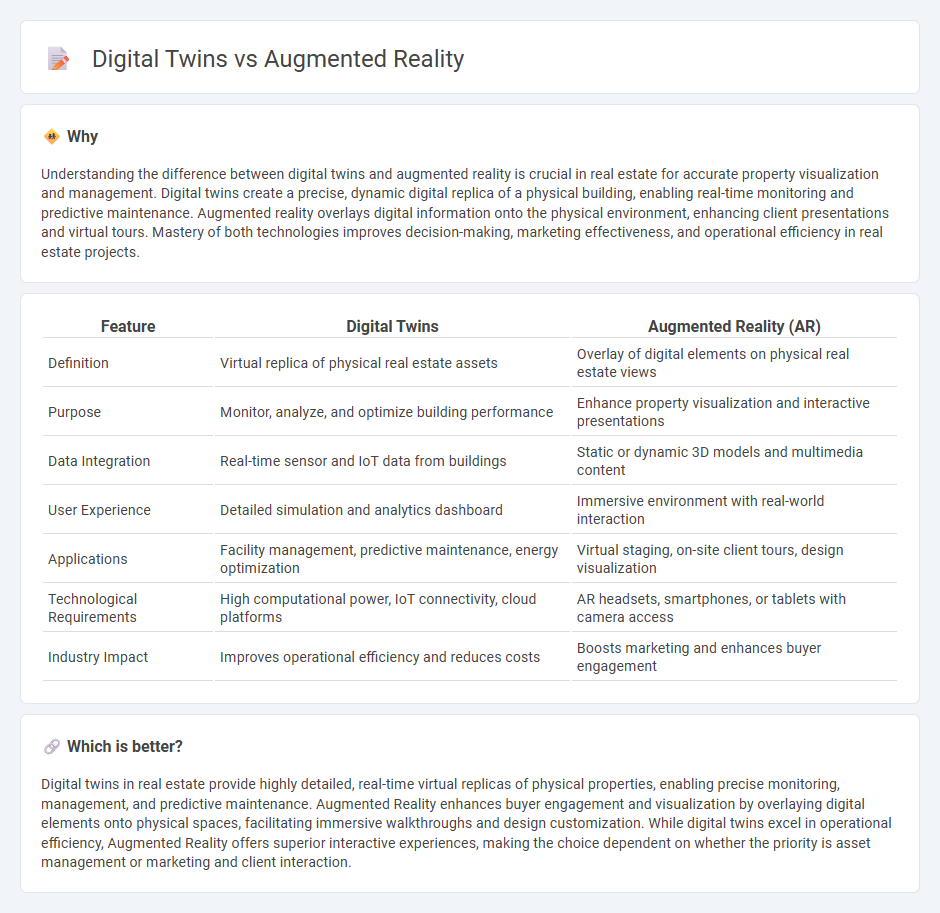
Digital twins in real estate offer precise virtual replicas of physical properties, enabling detailed analysis and management with real-time data integration. Augmented Reality enhances property visualization by overlaying digital information onto the physical environment, improving client engagement and design evaluation. Explore how these innovative technologies transform real estate experiences and decision-making processes.
Why it is important
Understanding the difference between digital twins and augmented reality is crucial in real estate for accurate property visualization and management. Digital twins create a precise, dynamic digital replica of a physical building, enabling real-time monitoring and predictive maintenance. Augmented reality overlays digital information onto the physical environment, enhancing client presentations and virtual tours. Mastery of both technologies improves decision-making, marketing effectiveness, and operational efficiency in real estate projects.
Comparison Table
| Feature | Digital Twins | Augmented Reality (AR) |
|---|---|---|
| Definition | Virtual replica of physical real estate assets | Overlay of digital elements on physical real estate views |
| Purpose | Monitor, analyze, and optimize building performance | Enhance property visualization and interactive presentations |
| Data Integration | Real-time sensor and IoT data from buildings | Static or dynamic 3D models and multimedia content |
| User Experience | Detailed simulation and analytics dashboard | Immersive environment with real-world interaction |
| Applications | Facility management, predictive maintenance, energy optimization | Virtual staging, on-site client tours, design visualization |
| Technological Requirements | High computational power, IoT connectivity, cloud platforms | AR headsets, smartphones, or tablets with camera access |
| Industry Impact | Improves operational efficiency and reduces costs | Boosts marketing and enhances buyer engagement |
Which is better?
Digital twins in real estate provide highly detailed, real-time virtual replicas of physical properties, enabling precise monitoring, management, and predictive maintenance. Augmented Reality enhances buyer engagement and visualization by overlaying digital elements onto physical spaces, facilitating immersive walkthroughs and design customization. While digital twins excel in operational efficiency, Augmented Reality offers superior interactive experiences, making the choice dependent on whether the priority is asset management or marketing and client interaction.
Connection
Digital twins create virtual replicas of real estate properties, enabling precise visualization and analysis of building performance and design. Augmented Reality enhances this process by overlaying these digital models onto physical spaces, allowing stakeholders to interact with and modify property features in real time. This integration streamlines property development, facility management, and client engagement by providing immersive, data-driven insights.
Key Terms
Immersive Visualization
Augmented Reality (AR) enhances immersive visualization by overlaying digital information on real-world environments, enabling interactive, real-time data interpretation. Digital twins provide detailed, dynamic digital replicas of physical assets, allowing for precise simulations and performance monitoring in virtual spaces. Explore how integrating AR with digital twins is revolutionizing immersive visualization and driving innovation across industries.
Virtual Representation
Augmented Reality (AR) superimposes digital content onto the physical world, enriching user perception with interactive virtual elements, while digital twins create precise, real-time virtual replicas of physical assets or systems for monitoring and simulation. AR enhances user experience by integrating virtual representations in real-world contexts, whereas digital twins focus on data-driven virtual models for operational optimization and predictive analysis. Explore how these technologies transform industries through advanced virtual representation techniques.
Real-time Interaction
Augmented reality (AR) enhances user experience by overlaying digital information onto the physical environment, enabling real-time interaction through intuitive gestures and spatial mapping. Digital twins provide a dynamic virtual replica of physical assets or systems, allowing for real-time monitoring, simulation, and predictive analysis to optimize performance and maintenance. Explore how integrating these technologies revolutionizes industries by enhancing real-time interaction and decision-making.
Source and External Links
What is Augmented Reality? | IBM - Augmented reality (AR) is the real-time integration of digital information into a user's environment, overlaying content onto the real world via devices like smartphones, tablets, or smart glasses, enhancing perception without replacing reality.
Augmented reality - Wikipedia - AR, also called mixed reality, overlays real-time 3D computer graphics onto the physical world through displays such as handheld devices or head-mounted displays, blending digital and real environments seamlessly.
What is augmented reality (AR)? | Definition from TechTarget - AR integrates digital information like images and sounds with the user's real-world environment in real time, often via smartphones, glasses, or headsets, altering perception without replacing the physical surroundings.
 dowidth.com
dowidth.com